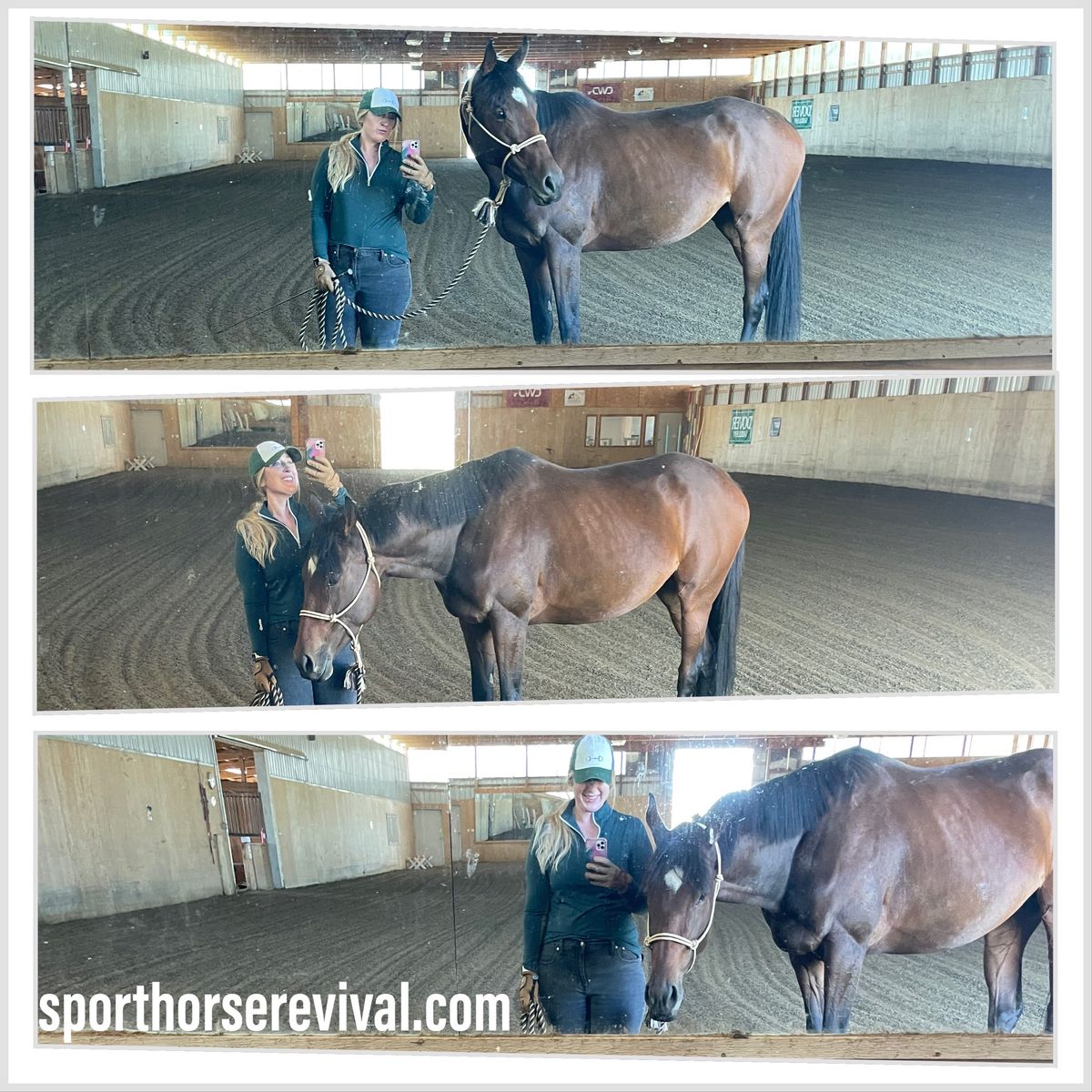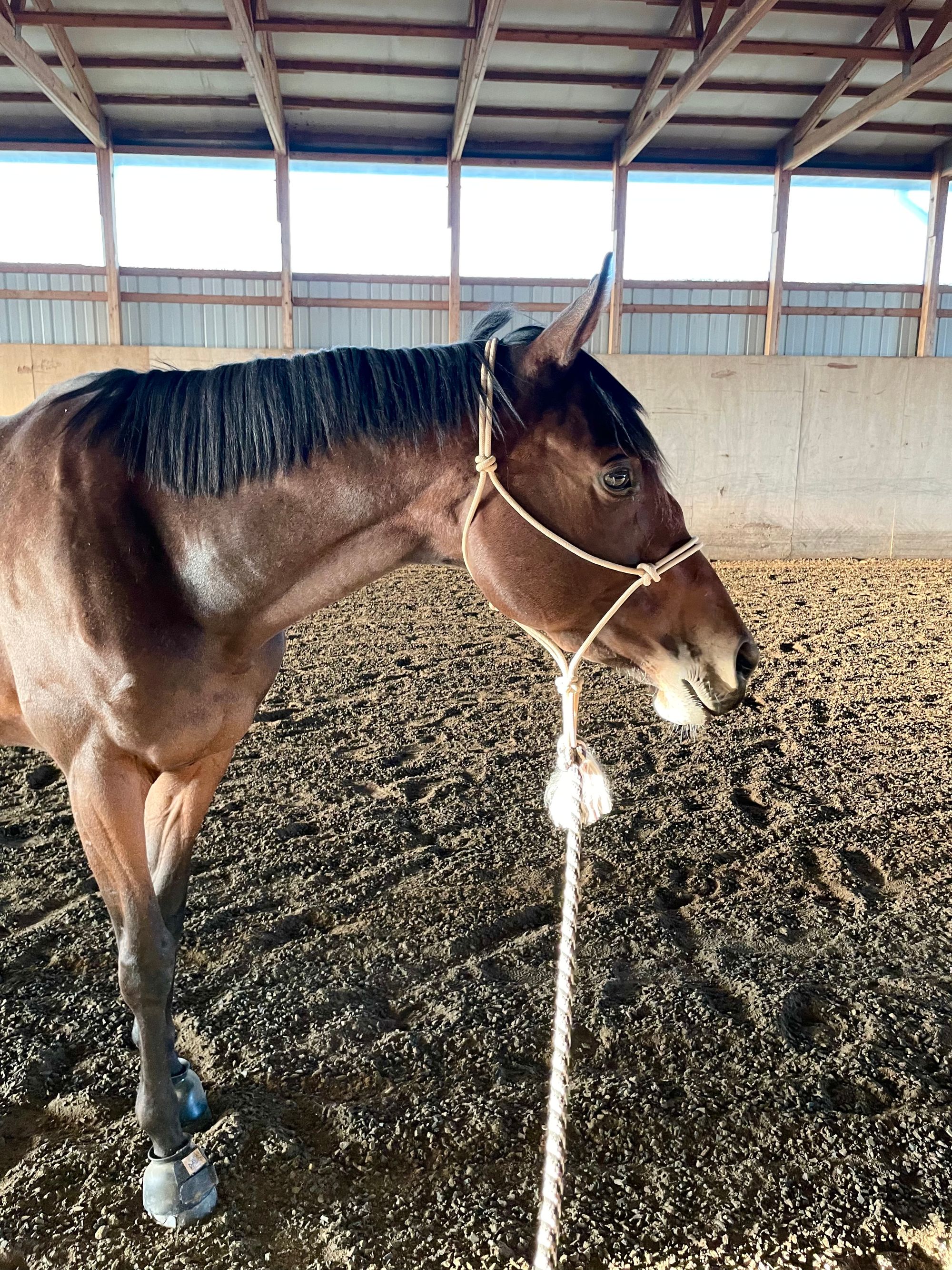In the Case of Colic

Shawnah began coming out for lessons once a week, which meant it was still up to me and the other trainer to work with her the other five days a week. Not working her wasn't a viable option, given her lack of turnout and needing a positive outlet for her baby energy. Since she was unrideable, we could really only work on handwalking to keep her fitness up and working her on appropriate behavior during grooming sessions.
One unlucky day, I arrived to routinely groom and handwalk Dixie. After just one lap around the arena, while taking some (shameless) selfies with her, I began to notice signs of colic.
In the photos above, you can see a progression of Dixie going from alert to sleepy. Her walk went from coordinated to clumsy. And when she put two front knees down, preparing to roll, I knew I had a problem on my hands.
Colic in horses can be deadly. Some of the most famous and high earning horses in the world have died from it. It stems from the fact that horses only have a one-way digestive system – in other words, they can't throw up. That means that unlike with dogs or other pets, eating something bad is a major problem and can often land horses in serious surgical intervention.
I have saved at least 10 horses from colic during my lifetime, and it's my goal to save as many as I possibly can - whether it be from taking action when I see a horse in distress or through educating others. Catching colic early means you have a high probability of success rate, or getting them to pass whatever the problem was, without veterinary intervention. Catching colic too late results in near certain death.
I immediately sprung to action and contacted my vet, my trainer, and the barn manager. Luckily, I had ordered a case of Cavalor 911 to keep on hand for colic situations like this. I gave her the designated amount and then we followed with a tube of banamine paste to keep down her inflammation and relieve pain. I kept her walking and denied her multiple attempts to roll.
Colicing horses should NOT:
- Be allowed to roll. My rule is to not even let colicking horses lay down because once they hit the ground, rolling is inevitable. Keep them on their feet - preferably walking - to help keep their digestion moving and their mind distracted from the discomfort. When a horse experiencing colic is allowed to roll, it usually results in twisting, flipping, or displacement of internal organs or intestines. Those situations are almost always surgically severe and most commonly result in death.
- Be allowed food. Not only can adding food to the already challenging digestive situation make matters worse, but you also need to begin preparing your horse for the very real chance they may need to have emergency surgery. In the first few hours you catch a colic, removing access to food is critical.
- Be left alone. Colic in horses can go from mild to deadly in a matter of hours. There is a fairly predictable pattern of a horse going from dull and lethargic, to bright and spritely, and then back to dull and lethargic. One key mistake many people make when managing colic is getting too hopeful too soon at the first sign of brightness. This phase will pass, as it is usually just a sign that the drugs you administered are kicking in or just a fleeting moment when they experience relief after consistent pain. The key is to continuously monitor them. Only when they reach a state of normalcy - not too dull, not too bright - can you begin to feel that you are out of the woods.
I let my work know that I would be needing the rest of the afternoon off so I could focus on getting Dixie better. I am lucky to work for a flexible and reasonable company that understands that animal kids are still kids, and sometimes kids need their parents.
I kept in contact with my vet on an hourly basis. He was hours away, so I opted to go with my trusted methods that had helped me save many other horses while continuing to consult with him over the phone. I knew if I could just help her make it to the evening, he could be at the barn if things took a turn. Hours of handwalking gave me a lot of time and space to think - for better or for worse. I played out all the scenarios in my head and shed a few tears at the thought of losing this special mare far before she even reached her prime.
I didn't care one bit about the money I invested her or the massive monetary loss I would take. It didn't matter to me that she was my one shot at having a horse and that if she passed, that would be the end of the road for me in this sport.
I just wanted my horse to live.
As the sun went down and we walked together side by side in the indoor with both end doors open to let the air flow through, the golden hour sunlight washed over her brilliant bay coat. I stopped to take a photo of her because of how beautiful she looked. Then, I noticed her eyes start to change. They went from conveying pain and anguish to instead conveying a softness and gratitude.

After she passed a healthy stool and I confirmed with the vet all signs were positive, we had successfully made it through the colic. I sighed with relief and put her away for the night, the barn staff promising to keep a close eye on her.
I think Dixie realized that day that even though she hadn't been the most kind or well-behaved lately, that I was here for her. No matter what.